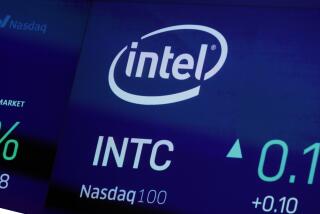IBM Pained by Industry’s Speedy Gnats
- Share via
What must IBM do? That’s one of the most interesting and important questions in U.S. business today.
But few felt they got much of an answer Tuesday when the giant computer company said it would cut its U.S. work force by 10,000 and repurchase up to $4 billion worth of its stock in an attempt to improve its competitiveness and increase shareholder value.
Reaction was swift and confused from a chorus of computer analysts and consultants. Some said IBM hadn’t gone far enough to cut its work force, while others said it hadn’t done enough to give power to its people in the field.
The reaction in the stock market--where IBM is held by more shareholders than any other issue--was lukewarm. For all the drama of the restructuring announcement by IBM Chairman John F. Akers and Chief Financial Officer Frank A. Metz to a hastily called morning meeting with security analysts, IBM stock rose only 37.50 cents a share to $99.625. Before the stock market’s crash in October, 1987, IBM sold for more than $170 a share. The total value of all its shares is now roughly $45 billion below that pre-crash figure.
The confusion was understandable, because IBM’s problems are complex. The company faces the dual challenge of how it copes with a changed industry and its own immense, $60-billion (sales) size and structure, which isn’t always an asset in today’s world.
A good part of IBM’s business today is affected by the shift of computing power to desktop computers--small machines that can do jobs of data processing that it once took rooms full of big computers to do. Technically, IBM is no slouch in small machines--its personal computers and workstations lead the $35-billion desktop market.
Rather the problem appears to be with speed and responsiveness--how fast a large worldwide company can react when the competition is often from companies like Dell Computer Co., a 5-year-old firm founded by a 24-year-old that sells computers by mail order and takes sales away from IBM.
Tiny Dell, and companies like Compaq Computer and Sun Microsystems, can compete with IBM because the power in computers these days comes from complex chips, called microprocessors, that are developed not by IBM but by companies such as Intel and Motorola who sell them to all comers. Thus virtually anybody with a knowledge of computers can put together a package of the latest microprocessor and a few additional features and compete with the giants. They can compete successfully, moreover, because the small firm’s costs are almost certain to be lower than those of the big company, which carries generous health and pension programs.
Once before, in the early 1980s, IBM reacted to such a challenge. Confronted by Apple Computer’s introduction of personal computers, IBM set up a separate operation to get it into the PC business fast. The PC was a great success and IBM was praised for being nimble.
But things are not so easy today. When IBM brought out the PC, customers still relied on IBM to deliver the computer power they needed. But now big and small companies mix and match computer hardware, thinking nothing of transferring data from a big IBM mainframe to desktop workstations from a variety of manufacturers.
IBM realizes this. “A computer today is nothing more than a package of the latest technology,” said IBM President Jack D. Kuehler in a recent interview. Therefore if the company is not on the market with the latest chips and software, at the lowest price, it’s not going to get the business no matter what its name or traditions.
So to adapt to this new cruel world, IBM began on Tuesday to slim down--cutting its work force through early retirements and hiring curtailments. And Chairman Akers indicated that this may not be the final cut.
But cutting costs may not be the whole answer. IBM has strengths no other company possesses. Its technical abilities are enormous, and its worldwide breadth and depth is an undoubted asset.
What must IBM do? Simply put, the company must find a way to take advantage of its size while coping with an industry where market power is fragmenting as technology changes. In all likelihood, many experts said Tuesday, the solution will involve IBM decentralizing its operations, sending power out to the field. “IBM needs to reduce headquarters staff and transfer authority to the field,” said Michael Maples, a former IBMer who is now a vice president at the software company Microsoft.
Clearly, it’s an immense and important challenge--not just for IBM and its employees. A lot of U.S. industrial leadership rides on its abilities, as do the savings of hundreds of thousands of IBM shareowners.
“IBM is fundamentally a strong company, with vast technological expertise,” said Andrew Heller, who was a vice president with IBM in Austin, Tex. “But it will take time for the company to work out its problems,” which appear to be more human than technical.
Times Staff Writer Carla Lazzareschi in San Francisco contributed to this story.
More to Read
Inside the business of entertainment
The Wide Shot brings you news, analysis and insights on everything from streaming wars to production — and what it all means for the future.
You may occasionally receive promotional content from the Los Angeles Times.










